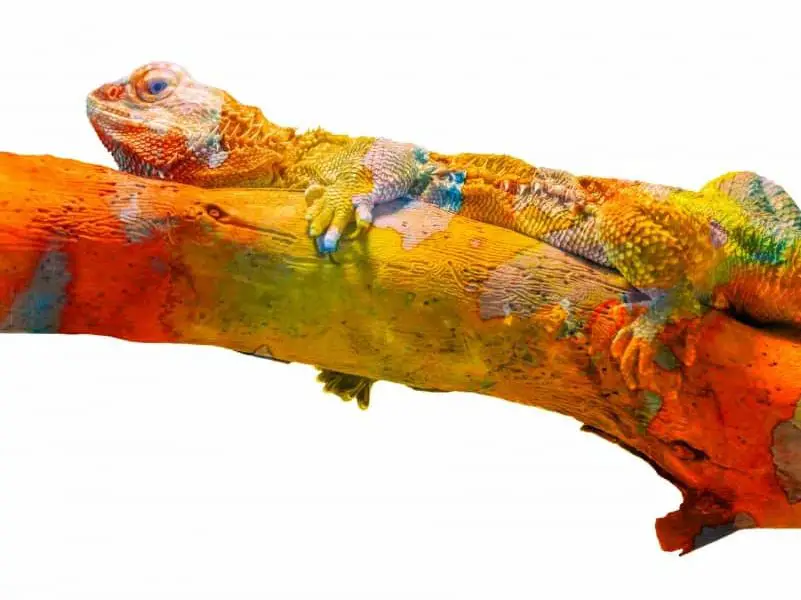Affiliate Disclosure: This post may contain affiliate links. If you make a purchase after clicking on these links I will be compensated at no extra cost to you. However, I never recommend anything I don’t love or wouldn’t use myself!
Everyone is always amazed at the cool and dazzling colors that bearded dragons possess. But bearded dragons also exhibit very different behaviors based on the colors of things they interact with.
What colors are bearded dragons attracted to and why? Bearded dragons have full color vision and react to different colors based upon their natural environment, as well as biological, hormonal or social factors. Color preference can depend on personal experiences and interactions with different objects, foods, or creatures.
Learning more about what your bearded dragon likes and dislikes allows you to understand your pet better and develop a strong relationship. It can be fun to experiment a little with color to learn more about what inspires your own beardie, so let’s talk about color, vision and how they make your beardie tick.
Why Are Bearded Dragons Attracted to Certain Colors?
Biology and Environment
Colors which bearded dragons display are usually the colors that they are also attracted to or at least have stronger reactions to. Bearded dragons change colors in different circumstances and so they are also more likely to respond to these shades as they can signal a variety of things.
When bearded dragons see colors that correspond to their own genetics, how they behave is somewhat preprogrammed.
This is why bearded dragons may behave differently around objects based purely upon their color. It may be an instinctive reaction based on their response to other dragons displaying such colors.
Researchers have also found a correlation between the range of colors a bearded dragon can display and the colors in their natural habitat.
For example, Mildura lizards are able to better blend in with the yellow sands that are prevalent in the region, while the Alice Springs lizards are better at matching their own native red sands.
Here’s a great video from the University of Melbourne that illustrates this.
Whether it’s food, a toy, or your shirt, an object might inspire a reaction in your bearded dragon, based solely on a genetically predisposed impression of its color.
Experiences and Interactions
Despite bearded dragon’s biological instincts, many bearded dragon owners have different experiences of their pet’s preference to colors. Some love certain bright colors such as red but get very stressed out over others like yellow or orange. However, other dragons may respond differently to these colors depending on their own experiences.
Here are some ideas for learning more about your dragons’ color preferences:
- Pay attention to the mood of your bearded dragon when you wear different colored shirts.
- It may be fun to give your beardie different colored food pellets (which all taste the same), to see if your pet prefers one color to another.
- If your bearded dragon has a favorite food, experiment to see if it’s actually the color that draws him close.
So, while some of the attraction to color is born from genetics, there is also something to individual preference. As you get to know your beardie better, you’ll start to learn the difference.
Let’s talk a little more about the colors bearded dragons change to and why.
Bearded Dragons Change Colors of Different Body Parts
Research shows that bearded dragons can change the color of different parts of their body for a variety of reasons including temperature fluctuations, camouflage, social interaction as well as to ward off rivals or predators.
- Bearded dragons have been seen to change the color of their chest and beard when interacting socially with other lizards. This color is typically creamy tan or jet-black, which is why other bearded dragons can be instinctively responsive to these colors.
- They will often change the color of their backs due to temperature fluctuations. Their backs turn bright yellows in warmer temperature and dark brown or black in cooler temperatures.
- When they feel stressed or are sick, they will turn black. While executing the puffing of the beard, they will usually turn it black as well.
Change in Temperature, Change in Color
Because of the weather extremes where these lizards live, it’s useful to have a mechanism for regulating temperature particularly as bearded dragons are cold-blooded.
The optimal internal temperature for a bearded dragon is 95° F (35° C). To accomplish this, the lizard’s back will change to a reflective bright yellow color in the heat and a heat absorbent dark brown in the cold.
It makes sense that this is the only body part that changes for temperature fluctuations as it is the only part that is exposed to the sun.
When the colors change, it happens very quickly which is a very important adaptation to rapidly warm or cool the internal body temperature.
Studies have been done to compare the bearded dragons to pale lizards. The bearded dragons that had dark backs reflected 8% of the sun’s light when compared to the 23% reflected by pale lizards.
Changing Color For Social Interaction
The chest and beard don’t change color during temperature regulation but instead, turn to cream and jet black when communicating with other lizards. Interestingly they also do “push-ups” and head bobs.
To show excitement or anger, the bearded dragon will darken up. Research also shows that showing a dark chest and neck displays dominant qualities that are attractive to a potential mate.
They may become a pulsating orange with a black beard to warn off rivals from their territory.
Interestingly, one study is soon to look at how all of these different color changes for different reasons may actually counteract each other.
We can see all the different colors a bearded dragon turns into, but how exactly do we know what they see themselves?
What Colors Do Bearded Dragons See?
Bearded dragons have fantastic color vision. They can actually see more colors than humans can. They are tetrachromatic, meaning they have four color receptors, where we only have three.
Bearded dragons can also see UV waves, which illustrates how important UV light is for them.
While bearded dragons have great color vision, due to the fact that their eyes are on the sides of their head, they have fairly bad depth perception causing some of their leaps to miss!
However, this also grants them a much larger field of vision than animals that have both eyes on the front of their heads.
Why Your Dragon Might Turn Black
Some owners report that their bearded dragon stays turned black all the time and hides. If this is the case for your beardie, they might be able to see something which scares them.
Due to their wide field of vision, as long as nothing is blocking their line of sight, they can usually see the entire room without moving their heads. They may see themselves in the mirror as well as birds outside.
Some bearded dragons stay turned black all day because they see too much and so they may be trying to camouflage even though they aren’t in any real danger.
To prevent this, it is key to provide your bearded dragon with hideouts where they can’t see any potential predators, and they feel safe.
How Far Can Bearded Dragons See
There is some controversy around this, but everybody agrees that they can see about as far as the average human. You can test out their visibility by going far back from their enclosure and pulling out whatever their favorite treat is, to see at what distance you get a reaction.
Relaxed bearded dragons are always focusing their eyes on things far away. If you put some food right in front of them, you can see their pupils adjust to see their prey much more clearly.
They will also tilt their head to see things that are in front of them much easier.
Do Bearded Dragons Have Vision in the Dark?
In short, no, they cannot see in the dark, they actually have pretty weak pupils. Because of this, bearded dragons know exactly when it’s time to sleep.
You need to make sure you have a lighting routine if you don’t have time switches because this can upset their biological clock.
With a disturbed biological clock, they will start roaming around their cage and become very stressed. Just be sure not to use a red light for your beardies…
Don’t Use a Red Light at Night for Beardies
A myth was started long ago that reptiles couldn’t see red light so people could use red heat bulbs at night, and this wouldn’t keep them awake. This has been proven to be false. Reptiles see things differently, but they can still see colors and lights like us.
If you want to test this for yourself, try watching TV in the same room as your dragon You will notice that your beardie watches it with you. This is because it sees the lights and images.
Research has shown that bearded dragons can see this and that disturbs their sleep. So, unless your bearded dragon has a sleeping spot completely hidden from the light, then you are probably disturbing their sleep.
You should not put any lights directly into the cage with your dragon because they need darkness to sleep properly. Set up a basking area far away from their sleeping area.
Red Lights Don’t Give Off UV
Red lights, in general, don’t give off UV light. They also provide little heat when compared to a bearded dragon’s natural environment of the desert. Beardies need better!
Some people recommend ReptiSun 10.0 UV lights with ceramic bulbs for the dragons basking area, this will provide heat and valuable UV light.
For heating purposes, bearded dragons need bright white light during the day. Any heat lamps that emit a red light during the night should be avoided at all costs.
How Long Should the Daytime Lights Be on for a Bearded Dragon?
Bearded dragons need at least 10-12 hours of lighting every day, the UV radiation is crucial for their health, without they will develop behavioral or mental problems, health issues, loss of appetite, and metabolic bone disease.
- It is recommended that you have at least 5-7 percent UVA and UVB radiation.
- UVA radiation: Helps your dragon stimulated and with a healthy appetite
- UVB radiation: Enables bearded dragons to metabolize calcium and vitamin D3
More tips on lighting for bearded dragons:
- Your fluorescent bulb should be at least 80% the length of the dragon’s enclosure.
- During the summer months, your bearded dragon should get 14-16 hours of light and UV exposure in the daytimes
- During the winter months, the hours of light and UV exposure should be decreased to 10-12 hours.
- Read and follow the manufacturer’s instructions for installing your specific model and brand of bulb
- Make sure you only use bulbs that are made specifically for desert reptiles.

